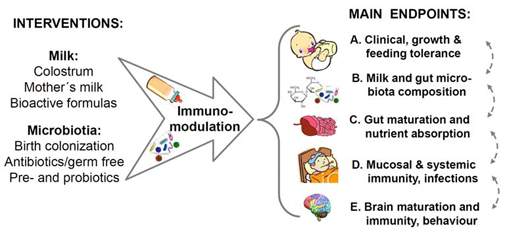Main endpoints
NEOMUNE has two interventions, milk and microbiota, and five endpoint areas.

An overview of the main interventions and categories of endpoints is shown here, and described in brief together with the laboratory analyses.
- Milk and microbiota composition
- Gut structure and nutrient absorption
- Mucosal and systemic immunity, infections
- Brain maturation and immunity, behaviour
Clinical, growth and food tolerance
Clinical endpoints are of crucial importance, not only in infant studies, but also in animal studies. They do not provide mechanistic explanations about treatment effects but are important when decisions are made regarding new dietary or microbial interventions for infants. NEOMUNE therefore include international experts in paediatric clinical nutrition and immunology as research leaders or on scientific advisory board. We choose clinical endpoints that are both important and feasible in clinical and experimental settings.
Milk and microbiota composition
Early gut bacterial colonization is affected by milk feeding and anti-, pre- and probiotics and is a key analytical target in NEOMUNE because it may affect mucosal and systemic immunity, but also the maturation of key organs like the gut and brain.
Chemical analytical capacity for the milk products to be used in the studies mainly reside with associated, industry partners delivering the milk products, but also by academic expertise (especially for WPs 1.2/1.4/2.3/2.4).
Among the partners we have established a large platform of analytical techniques from conventional culturing methods, mucosa-associated bacterial adhesion, molecular bacterial profiling to high-throughput sequencing with the necessary bioinformatics capacity. Differences in the combined metabolic result of the gut microbiota and luminal nutrition are studied by analyses of short-chain fatty acid concentrations and for WP 2.2 also by metabolomics profiling of urine samples, according newly developed methods.
Gut structure and nutrient absorption
In a selected number of pig studies, we make a detailed transcriptomic, epigenomic and proteomic analysis of the tissue responses to differences in the first feeding and gut microbiota (WP 2.2/2.3/2.4). We build on our significant experience in structural and functional analyses of gut tissue that we have applied to both pigs and infants with NEC (21).
Mucosal and systemic immunity, infections
In NEOMUNE, infant infections are defined according to international standards for clinical assessment of gut and airway infections, with or without evidence of fever, sepsis and bacterial translocation. Care will be taken to standardize the clinical criteria within and among the infant studies.
In piglet studies, mucosal immunity will be investigated at the level of the gut mucus layer, goblet cells and bacterial adhesion, coupled with an established panel of cytokines, both at the protein and mRNA level. In mice, infections and vaccination responses (blood antibody, cell density, cytokine levels) will be used to assess immune competence (WP 3). Specific for mouse studies, expression of selected immune-related genes is assessed in a number of immune-related organs, gut, liver, spleen and brain. The T-cell polarization will be investigated after flow-cytometry isolation (4).
Bacterial adhesion, proliferation and immune responses of selected milk bioactives in WP 2.4 will be subject to studies in isolated cultures of intestinal cells. Systemic immunity for infant and pig studies is assessed by the bacteria-stimulated cytokine response in whole blood cell cultures.
Brain maturation and immunity, behaviour
Links among early diet, microbial colonization, immunity and the developing brain are well established but cause effect relationships have not been established.
In NEOMUNE, we benefit from the hypersensitive state of the immature gut and brain in preterm neonates to show mechanisms. We couple standard cognitive and motoric tests for preterm infants (BSID III; WP 1.4), with novel cognitive and brain structural studies developed for preterm pigs (WPs 2.1/2.3/2.4), supplemented also by behavioural tests in mice (WP 3.1) following manipulation of diet and gut microbiota.
We focus specifically on tests directed towards pre-frontal cortex function, on neocortex neuron densities and their enrichment with milk bioactives (LC-PUFA, sialic acid, gangliosides, phospholipids), phenotype and density of brain glial cells and their associated cytokine responses (IL-1β,IL-6).

